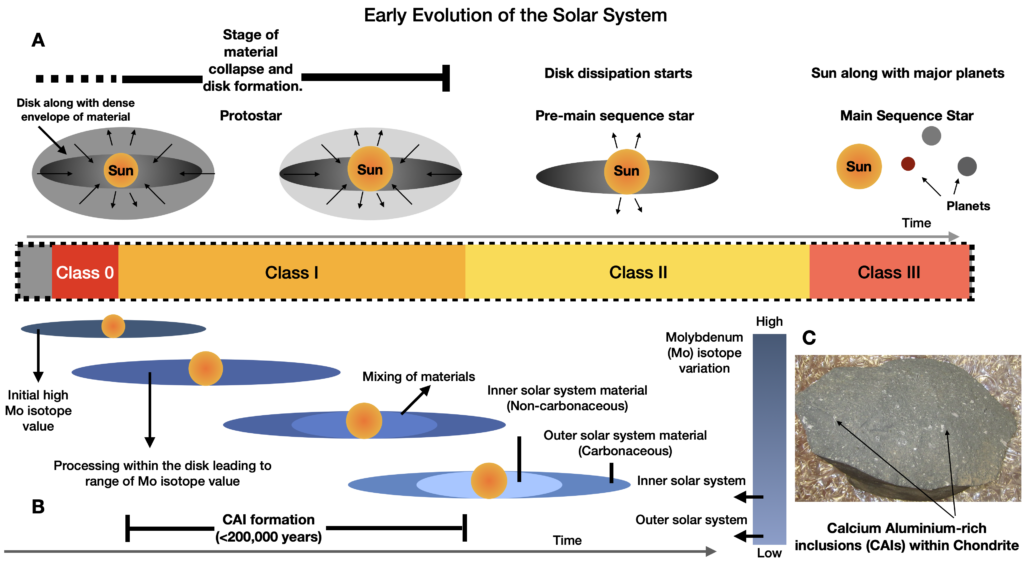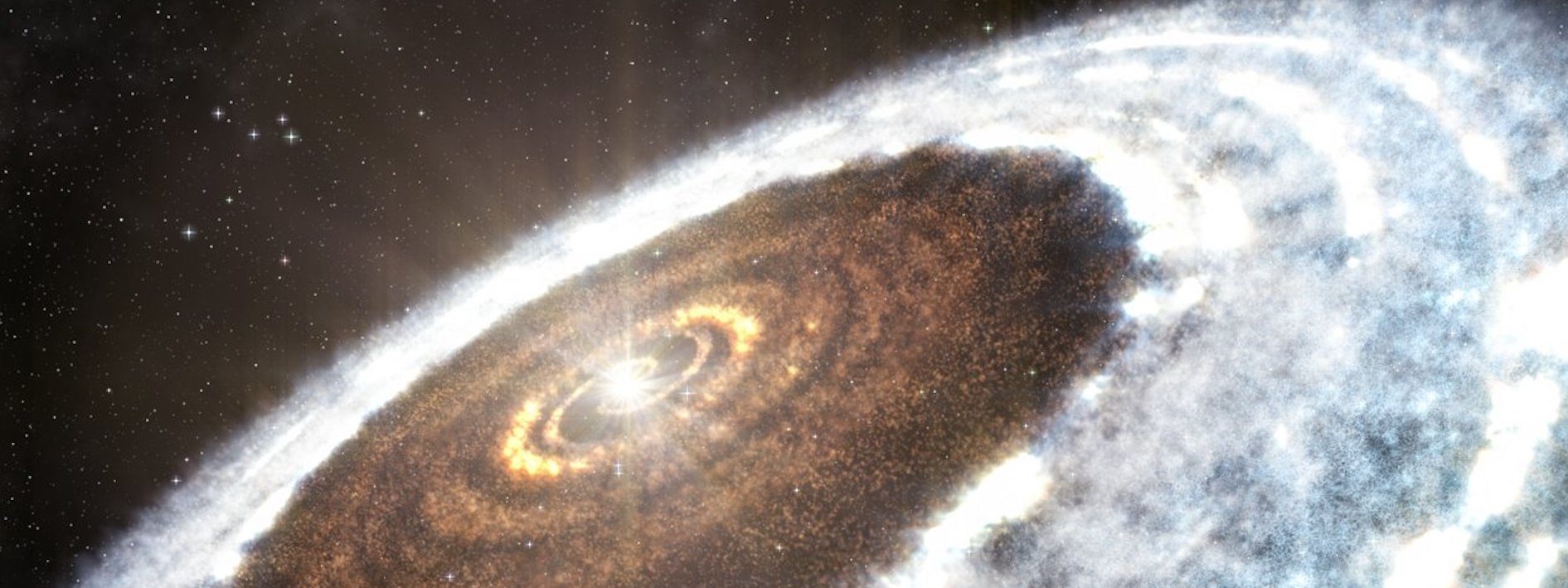Paper: Astronomical context of solar system formation from molybdenum isotopes in meteorite inclusions.
Featured image: Artistic impression of the protoplanetary disk. Image used with permission from Wikipedia (A. Angelich).
Authors: Gregory A. Brennecka, Christoph Burkhardt, Gerrit Budde, Thomas S. Kruijer, Francis Nimmo, Thorsten Kleine.
If you ask a cosmochemist what the oldest objects in the solar system are, they will swiftly answer the Calcium Aluminium Inclusions (CAIs), a small light-coloured inclusion within primitive meteorites known as Chondrites (see figure 2C). However, if you ask what event in the solar system evolution CAIs correspond to, it is a more challenging question. Previously, CAI formation was associated with the various evolutionary stages of our Sun. However, as the timescale of evolution of Sun, calculated to be around 1 million years by observing Sun like stars, is longer than the CAI forming period (~ 40,000 – 200,000 years), the association between CAI formation and the early stages of our Sun is not always clear. In a quest to put the CAI formation in an astronomical context, a recent study from Brennecka et al. analysed CAIs present within various Carbonaceous chondrite meteorites and linked the CAI formation to a specific stage in the Sun’s evolution.
According to the most widely accepted hypothesis of our solar system formation (Nebular Hypothesis), the Sun and all other planetary bodies formed from the collapse of a giant cloud of molecular gas and dust. In the early stages of the Sun’s evolution, dust and gas came together to form the central Sun and a rotating disk structure (see Figure 2A). Later, the disk began to dissipate, and the Sun grew to almost its present mass and the major planets were formed . As the gas and dust started to condense, various solid objects began to form, creating our solar system. CAIs are some of these earliest solid objects. They formed close to the young Sun and were subsequently transported to the outer regions, later being incorporated into chondrite meteorites as centimetre-sized inclusions.

To link the CAI formation to the solar evolution , Brennecka and co-authors observed the isotopic variation of molybdenum in the CAIs. Isotopic differences called nucleosynthetic variations arise due to irregular distribution of materials within the disk-like envelope around the early Sun (see figure 2B). This irregular distribution of materials divided the disk-like envelopes into two compositionally distinct pools corresponding to the inner solar system and the outer solar system’s material, scientifically named as non-carbonaceous and carbonaceous material, respectively. Using molybdenum isotopes, a researcher can differentiate between the materials that form in our inner and outer solar system. The inner solar system material being close to the Sun incorporated molybdenum of different isotopic composition than the outer solar system. And as these differences are believed to appear very early in the solar system history (within the span of solar evolution), these isotopic variations allowed the authors of this study to understand the formation of CAIs.
The 15 CAIs selected by the authors of the study cover an entire range, starting from low molybdenum values corresponding to non-carbonaceous inner solar system pool to the values even higher than the outer solar system pool. The authors interpreted this gamut as a link between CAIs and the early Sun stage when the material was continuously being added to the Sun and the surrounding disk envelope (see figure 2B). According to the model proposed, the initial star formation started with the high molybdenum values and later changed to lower non-carbonaceous like values. Thus, these CAIs can now be utilised to understand the initial evolution of Sun-like stars.
As any change in the isotopic values might reflect an underlying process, the molybdenum isotope variation might have several possible origins. It could be possible that the change in molybdenum values reflect the timely change in the composition of gas from which CAI condensed, or the change as host meteorite experienced alteration on their parent body, or the processing of CAIs before its incorporation into host meteorite . To further resolve this, Brennecka and his team also investigated variations in titanium and tungsten isotopes. Tungsten and molybdenum isotopes behave similarly in any alteration process because of their iron-loving nature. Thus, if the observed molybdenum isotope variation results from an alteration in the host, then tungsten isotope should also show a similar signature to molybdenum. The investigators found no correlation between the tungsten and molybdenum isotopes, implying that the parent body’s alteration cannot cause the observed molybdenum isotope variations. Unlike tungsten, titanium isotope record variation in the composition of the gas. If the observed molybdenum range is due to continuous change in gas composition, both molybdenum and titanium isotopes, having the same carriers, should show identical signatures. However, the evaluated titanium and molybdenum data’s differences suggest that the observed molybdenum isotope variation cannot be explained solely by the change in gas composition from which CAIs condensed. And, perhaps, CAIs acquired these varied molybdenum isotope values while being processed within the evolving disk that enveloped the young Sun and before being incorporated into the host meteorites. However, as the authors point out, further study is still needed to know the reason behind this behaviour of molybdenum.
In this study, Brennecka and co-workers conclude that the range of molybdenum isotopes in CAIs links their formation to the transitional stages of the Sun, from class I to class II in astronomical terms (see figure 2). This finding also means that researchers can estimate this transition stage’s timescale for other stars like our Sun to be around ~200,000 years (CAI formation timescale), consistent with astronomical observations. Apart from confirming the previous observations, this study reported physical samples that define our solar system’s age . This means now we have physical samples in the form of CAIs to represent various stages of the Sun’s evolution. Using these samples, we can ascertain the prevailing physical conditions such as temperature and chemical environment during that time.
Capturing Early Sun within meteorite inclusions by Yash Srivastava is licensed under a Creative Commons Attribution-ShareAlike 4.0 International License.

